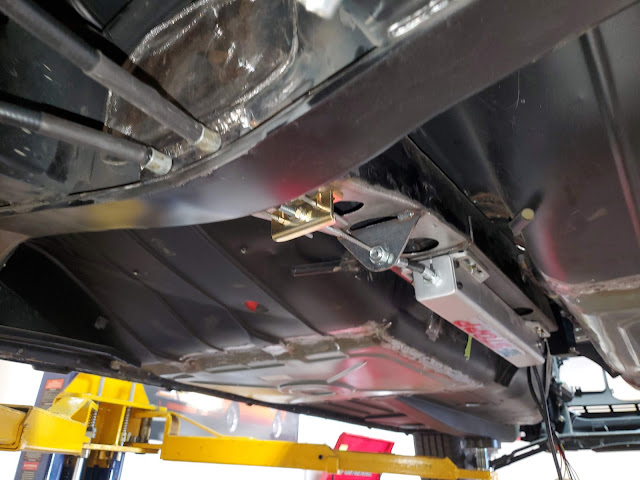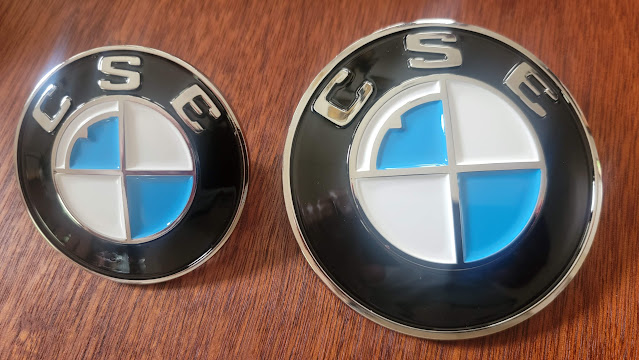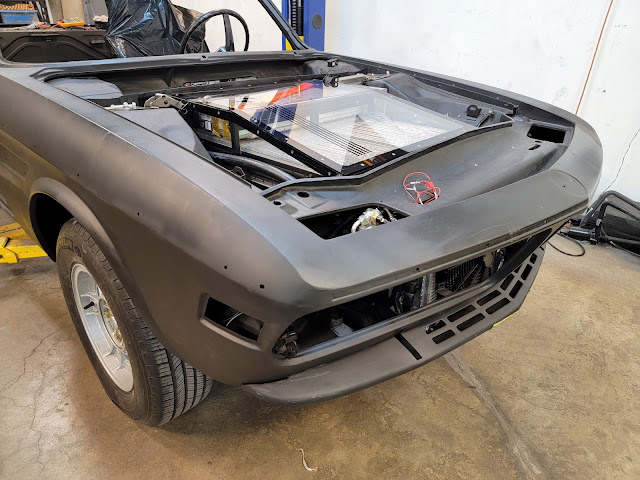Different strokes
As you probably know, I'm not converting just one BMW 3.0 CS coupe to Tesla power but two. One for me and one for my son-in-law, Alex. In fact, I'm involved in a third project for a customer as well. Brett Perkins at P3 Conversions is handling that build and I just consult a bit but I thought it would be interesting to compare how each project has tackled similar problems in different ways.
The other day someone asked me what the most difficult problem to solve was on my project. I answered "finding room for the batteries" because that leads to a slew of other problems. Most notably is how make enough room for a big square battery box while still leaving room for brakes and steering. Neither can be freely relocated since they need to connect to the pedals and steering column. Yet both power steering and power brakes are mandatory accessories that typically take up a lot of space. Each project has tackled this differently.
Car #1
The first project (the silver CSE for Alex) is the only one fully on the road today and uses a hydraulic rack and pinion from a VW along with a modern BMW steering column and an electric hydraulic pump from a Mini Cooper. The steering knuckles were modified to mate to the VW tie rod ends.

|
| VW steering rack and brakes where the transmission used to be |
That same Mini Cooper pump also powers the brakes via a hydroboost unit and Wilwood master cylinder relocated into the transmission tunnel via a crazy lever (named Fred) that is mounted to the firewall and converts the forward push of the brake pedal into a backward push of the hydroboost in the trans tunnel. Brett's ideas and fabrication skills always amaze. Nothing is impossible for him. This approach freed up enough room to fit 12 batteries up front.

|
| A closeup of Fred, the brake direction changer |
Ground control coil over suspension and big Wilwood brake calipers, with Tesla electric parking brake calipers, complete the customizations of brakes and steering on Alex's car.

|
| Ground Control coilovers and Wilwood 6-piston brake calipers up front |

|
| Wilwood rear calipers and electric Tesla parking brake calipers |
For vehicle drive unit control, precharge control, charging, BMS, and DC/DC conversion, Car #1 uses:
- Drive Unit Control - 057 Technology
- Precharge Control - Timer relay
- Charging - Valeo 6.6kw OBC
- DC/DC - Tesla Model S
- Battery Management - Orion BMS 2
 |
| Fusebox, audio amp and DSP, Tesla DC/DC Converter, Tesla junction box, and Valeo OBC |
Car #2
All that was designed by Brett and Paul and scared the crap out of me so for the second project (my car) I opted to keep as many original parts as possible. This car uses the stock steering components but replaces the original engine-driven power steering pump with the same Mini Cooper electric version.

|
| Stock steering gearbox and suspension with slightly relocated iBooster brakes and Mini Cooper pump |
On this car, power assist for the brakes comes not from hydraulics but via a Tesla iBooster electric power brake unit. To make room for this, the brake pedal push rod was moved over into where the clutch pedal normally exits the firewall and Brett fabricated a custom bracket to mount the iBooster out of the way of the battery box. That box had to be designed to clear the stock steering box, resulting in only enough room for 10 batteries up front.

|
| The relocated iBooster just barely clears the battery box, which is notched out for the steering gearbox and Mini Cooper pump |
Other than the iBooster assembly and a Wilwood proportioning valve, the rest of the brakes are original (rebuilt) BMW. The original parking brake cables are engaged by an electric linear actuator. The suspension is similarly original, but with slightly lowered strings and camber plates. All this is proven and has been driven, albeit only for a few blocks since the car is still undergoing restoration.

|
| Stock front suspension and brakes |

|
| Stock rear suspension and brakes |

|
| Linear actuator pulls stock parking brake cables |
For vehicle drive unit control, precharge control, charging, BMS, and DC/DC conversion, Car #2 uses:
- Drive Unit Control - 057 Technology
- Precharge Control - ZEVA Smart Precharger 1.3
- Charging and DC/DC - Ovartech 6.6KW OBC+1.5KW DC-DC Liquid-cooled On Board Charger
- Battery Management - Orion BMS 2
 |
| Fusebox, Contactor box, Ovartech OBC/DC-DC |
Car #3
The latest project (a 2800 CS for customer Sam) recognized that the Mini Cooper electric power steering pump is loud and doing less in my car than Alex's so could be eliminated entirely via the use of electric power steering. A aftermarket electric power steering rack was sourced and adapted to the stock steering column shaft. This required some customization to the steering knuckles to eliminate bump steer.
 |
| Aftermarket electric power steering rack. and relocated low profile master cylinder |
 |
| Steering column drilled, threaded, screwed together, and brazed to adapt stock column to custom rack |
The brake master cylinder was replaced with a low profile version and relocated. This required Brett to do some significant design and modification to the brake pedal pushrod setup, using a modified Tesla brake pedal assembly.
 |
| Modified Tesla brake pedal to relocated master cylinder with proper 4:1 throw |
Power assist for the brakes on this car comes from a remotely located electric pressure pump with an accumulator. This allows for about 10 full panic stops before the accumulator needs to catch up. In the event it falls behind, the car reverts to manual brakes. The pump can be located anywhere and is just connected hydraulically to the master cylinder. As a result, enough room has been freed up for 12 batteries up front.
 |
| Remote located electric brake pressure boost pump |
Like Alex's car, Sam's car sports Ground Control coil overs and big Wilwood brakes but uses the same parking brake solution as my car. While this whole setup is as yet untested, it promises some improvements over previous solutions, including speed-sensitive steering assist (via GPS) and elimination of noise and oily bits.
For vehicle drive unit control, precharge control, charging, BMS, and DC/DC conversion, Car #3 uses an integrated all-AEM system:
- Drive Unit Control - AEM VCU 300
- Precharge Control - Resistor and AEM VCU 300
- Charging and DC/DC - AEM EV 30-8405 EV Combined Charging Unit (CCU) 6.6kw OBC with 2.5Kw DC/DC
- Battery Management - AEM EV 30-8401M and 30-8401A Battery Management System Master and Satellites
 |
| Contactors, precharge resistor, AEM CCU, AEM BMS |
Different strokes for different projects.


